| CHEVROLET MONTE CARLO History
Introduction:
The Chevrolet Monte Carlo was introduced in 1970 at the height of GM muscle
car power. Positioned as a personal luxury car, the Monte Carlo competed
against the Pontiac Grand Prix and Buick Riviera for the gentlemen's performance
market. However, right after its introduction, performance fell out of
favor in Detroit and its short life as a muscle car ended almost as soon
as it began.
1970 Chevrolet
Monte Carlo (first generation 1970-72)
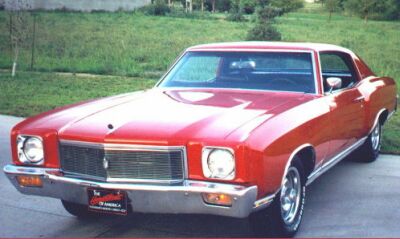 Comments:
The 1970 Monte Carlo was introduced on September 18, 1969, but drew only
a cool reception from enthusiast magazines who were still caught up in
muscle car mania. But the Monte Carlo, which was only available as a four
person luxury two door coupe, was a hit with buyers, who snatched up 145,975
examples. Monte Carlos were based on the Chevelle but rode on an 116 inch
wheelbase and had the longest hood ever fitted onto a Chevrolet. All Monte
Carlos came with at least a 350 cubic inch V8, but any big block Chevelle
engine was available. At the top was the Monte Carlo SS454, which 3,823
buyers snatched up, which came with the mighty Chevy 454 block. The SS45
package, option Z20, included the 454 big block engine, a heavy duty suspension,
"SS454" badging on the rocker panels and deck lid, a remote control sport
mirror, thin black rocker panel stripes, heavy-duty battery, automatic
level control suspension, air shocks, dual chrome exhaust extensions, 15x7
inch Rally wheels, and GTO-15B white stripe tires. The vast majority of
the SS454 came with the LS-5 454 engine, rated at 350 bhp. But about 10
were snuck out of the factory with the LS-6 454 engine, rated at 450 bhp.
A very few four speed Monte Carlo SS454s were made too. Comments:
The 1970 Monte Carlo was introduced on September 18, 1969, but drew only
a cool reception from enthusiast magazines who were still caught up in
muscle car mania. But the Monte Carlo, which was only available as a four
person luxury two door coupe, was a hit with buyers, who snatched up 145,975
examples. Monte Carlos were based on the Chevelle but rode on an 116 inch
wheelbase and had the longest hood ever fitted onto a Chevrolet. All Monte
Carlos came with at least a 350 cubic inch V8, but any big block Chevelle
engine was available. At the top was the Monte Carlo SS454, which 3,823
buyers snatched up, which came with the mighty Chevy 454 block. The SS45
package, option Z20, included the 454 big block engine, a heavy duty suspension,
"SS454" badging on the rocker panels and deck lid, a remote control sport
mirror, thin black rocker panel stripes, heavy-duty battery, automatic
level control suspension, air shocks, dual chrome exhaust extensions, 15x7
inch Rally wheels, and GTO-15B white stripe tires. The vast majority of
the SS454 came with the LS-5 454 engine, rated at 350 bhp. But about 10
were snuck out of the factory with the LS-6 454 engine, rated at 450 bhp.
A very few four speed Monte Carlo SS454s were made too.
Production:
SS454: 3,823
Engines:
454 V8 360 bhp, 500 lb-ft @ 3,200 rpm. 454 V8 450 bhp.
Performance:
454/360: 0-60 in 7.7 seconds, 1/4 mile in 16.2 seconds @ 90 mph.
1971 Chevrolet
Monte Carlo
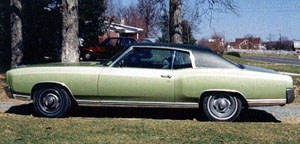 Comments:
For 1971, a blacked-out rear body panel was added to the SS package, along
with a heavy-duty front and rear suspension, front and rear stabilizer
bars and dash control knobs with international symbols. Some, but not all,
had a new rubber rear bumper insert. Despite falling horsepower ratings
for other GM motors in 1971, the LS-5 454 actually was rated at 365 bhp,
an increase of 5 bhp. A handful of Monte Carlos were ordered with the LS-6
454, down rated to "only" 425 bhp. Comments:
For 1971, a blacked-out rear body panel was added to the SS package, along
with a heavy-duty front and rear suspension, front and rear stabilizer
bars and dash control knobs with international symbols. Some, but not all,
had a new rubber rear bumper insert. Despite falling horsepower ratings
for other GM motors in 1971, the LS-5 454 actually was rated at 365 bhp,
an increase of 5 bhp. A handful of Monte Carlos were ordered with the LS-6
454, down rated to "only" 425 bhp.
Production:
SS454: 1,919
Engines:
454 V8 365 bhp. 454 V8 425 bhp.
Performance:
454/365: 0-60 in 7.7 seconds, 1/4 mile in 16.2 seconds @ 90 mph.
Second Generation
(1973- 1977)
The
1973 Chevrolet Monte Carlo had a drastic change in body design as
well as interior changes and suspension upgrades. The body design
was the "largest" of all Monte Carlos in exterior dimensions. Rounded,
flowing fenders and a long hood were the main features. Single round headlamps
were again used. Bumpers now met the federal 5 mph standard. The interior
was redesigned and both cloth and vinyl trims were available. New for 1973
were swivel bucket seats that turned outward ninety degrees for ease of
entry and exit of the vehicle. Overall, there were three trim levels available:
the base coupe, Monte Carlo S and the Landau. The base coupe Monte Carlo
came standard with a 350 cubic inch V-8
and
3-speed manual transmission, although, again, the manual transmission was
very rare. The S was the same as the base coupe, but with standard power
steering and radial tires. The top-of-the-line Landau package included
Landau badging, a special vinyl top, left and right hand sport mirrors
and Turbine II aluminum wheels. A center console was available and the
shifter for automatic
transmissions
was a stick type with the release button on top. Optional engines included
the 350 inch V-8 with 4-barrei carburetor and the 454 V-8.
For
1974, the Monte Carlo changed little from 1973. No base coupe
was offered this year, just the Monte Carlo S and Landau. Minor exterior
changes included revisions to the grille and taillamps and a reworked rear
bumper. The interior was basically unchanged from 1973 except for the addition
of standard shoulder restraint belts, in accordance with federal law.
Among the engine choices for
1974
(which still included several versions of the 350 V-8 and a 454 V-8) was
a new choice; the 400 cubic inch small-block V-8. This engine was available
in 150 and 180 net horsepower versions with a 2 barrel and 4 barrel carburetor,
respectively. A 3-speed manual transmission was shown as base equipment.
As always in the Monte Carlo, a manual transmission was extremely rare.
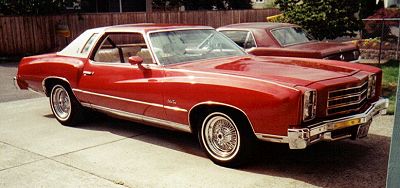 1975
brought very few changes over 1974. Again, minor revisions were made to
bumpers, exterior lighting and the Monte Carlo emblems. The interior trim
remained the same except for a new split bench seat option. Engine choices
remained the same and transmission choices still included a 3-speed manual.
(Technically, the 3-speed manual was available but it is speculated that
none may 1975
brought very few changes over 1974. Again, minor revisions were made to
bumpers, exterior lighting and the Monte Carlo emblems. The interior trim
remained the same except for a new split bench seat option. Engine choices
remained the same and transmission choices still included a 3-speed manual.
(Technically, the 3-speed manual was available but it is speculated that
none may
have
ever reached customers.)
The
Monte Carlo for 1976 retained the same overall body style used from
1973-1975, but had a new look up front. Instead of single round headlamps,
the 1976 sported dual, stacked, rectangular headlamps. Once again
the grille and taillamps were updated. Interior equipment was basically
carry-over from 1975. The engine option list was modified by dropping
the 454 V-8 (never to appear in the Monte Carte again) and by adding a
305 V-8. An automatic transmission was made standard equipment and a manual
transmission was not to be seen again until 1978.
1977
marked the final year of the "big" body style for the Monte Carlo. Very
few changes were made to exterior or interior. The grille was slightly
different, with the Monte Carlo medallion removed from the grille and changed
into a hood ornament. Taillamps had added horizontal ribbing. Engine choices
were cut down to a 305 V-8 and an optional 350 V-8. The automatic transmission
was standard
equipment.
Third Generation
(1978- 1980)
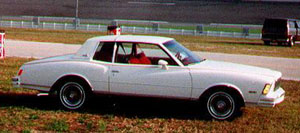 In
1978 the Monte Carlo underwent such major changes that the new style
warranted the designation "third generation." The Monte Carlo was completely
restructured; from it's new smaller, but still traditionally curved exterior,
to it's shorter wheelbase and reconfigured frame and suspension. The front
styling maintained a "Monte Carlo" look, but went back to single headlamps
of a rectangular design. Bumpers were integrated into the body, covered
with flexible polyurethane plastic and painted body color. The hood remained
somewhat long, and the trunk somewhat short in the same style as previous
years, but on a smaller scale. The 7978 model shaved approximately 500
pounds in weight from the 1977 model, and now offered a smaller, lighter,
V-6 base engine. Along with the base Buick-built 231 cubic inch V-6 engine,
a Chevrolet-built 305 cubic inch V 8 was offered. Transmission choices
included a 3-speed manual, a 4-speed manual, and a 3-speed automatic. Like
in previous years, the manual transmissions were rare. The interior of
the new 1978 Monte Carte was restyled with an instrument panel design composed
of a drivers “pod” for instrumentation, and a low mounted central
“pod” containing the heater and air conditioner controls, cigar lighter,
and audio system controls. This dash design would remain relatively unchanged
through 1988. Also available was a center console. In
1978 the Monte Carlo underwent such major changes that the new style
warranted the designation "third generation." The Monte Carlo was completely
restructured; from it's new smaller, but still traditionally curved exterior,
to it's shorter wheelbase and reconfigured frame and suspension. The front
styling maintained a "Monte Carlo" look, but went back to single headlamps
of a rectangular design. Bumpers were integrated into the body, covered
with flexible polyurethane plastic and painted body color. The hood remained
somewhat long, and the trunk somewhat short in the same style as previous
years, but on a smaller scale. The 7978 model shaved approximately 500
pounds in weight from the 1977 model, and now offered a smaller, lighter,
V-6 base engine. Along with the base Buick-built 231 cubic inch V-6 engine,
a Chevrolet-built 305 cubic inch V 8 was offered. Transmission choices
included a 3-speed manual, a 4-speed manual, and a 3-speed automatic. Like
in previous years, the manual transmissions were rare. The interior of
the new 1978 Monte Carte was restyled with an instrument panel design composed
of a drivers “pod” for instrumentation, and a low mounted central
“pod” containing the heater and air conditioner controls, cigar lighter,
and audio system controls. This dash design would remain relatively unchanged
through 1988. Also available was a center console.
Changes for 1979 were
few. Minor cosmetic adjustments were made to the taillamps, headlamps,
and grille. The interior remained virtually unchanged. There were new engines
available for 1979, including a 267 cubic inch V-8 and a 200 cubic inch
V-6. The 200 cubic inch V-6 was a Chevrolet designed engine entirely different
from the Buick designed V-6 that was still available. (Quick visual identification
hint: Chevrolet V-6 has distributor in rear: Buick V-6 has distributor
in front.) The 305 cubic inch V-8 was given a 4 barrel carburetor and was
the most powerful engine available for the year. The manual 3-speed transmission
was still in the line-up, but was only available with the base 200 cubic
inch V-6.
Ordering RPO code F41 gave
the Monte Carlo a performance handling package that included heavy duty
sway bars front and rear.
In 1980 the Monte
Carlo retained the same overall "third generation" body lines, but added
dual side-by-side headlamps and again refined the grille. The rest of the
vehicle remained basically unchanged. Another engine was added to the list
of those available: a turbocharged 231 cubic inch V-6 rated at 170 net
horsepower. Along with the turbo engine came a small hood bulge labeled
"TURBO" with a Chevrolet Bowtie emblem. The previous year’s 200 cubic inch
V-6 was increased
in displacement to 229 cubic
inches. Gone for good in the Monte Carlo was the manual transmission.
Fourth Generation
(1981- 1988)
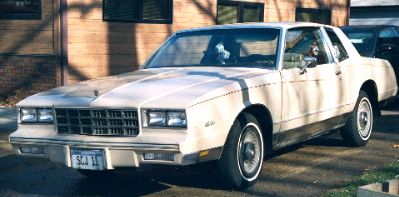 1981
brought about the fourth generation of Monte Carlo. Although the car kept
the same general frame, suspension and drivetrain, the body was redesigned
completely. The curved body lines of the third generation model were smoothed
and straightened. Side body panels still featured the classic Monte Carlo
curves, but they were much subdued. The car had a sharp squared look. Although
the 1981
brought about the fourth generation of Monte Carlo. Although the car kept
the same general frame, suspension and drivetrain, the body was redesigned
completely. The curved body lines of the third generation model were smoothed
and straightened. Side body panels still featured the classic Monte Carlo
curves, but they were much subdued. The car had a sharp squared look. Although
the
1981 model may have appeared
somewhat larger than the third generation models, it was not. Weight stayed
roughly the same. The front seemed to narrow into a wedge-type shape. The
rear contained vertical tailamps and a raised deck. Front and rear bumpers
were again molded into the body. The interior contained similarly styled
door and quarter panels, and the instrument remained the same,
overall. Powertrain choices
again included the turbocharged 231 V-6 and all engines received Computer
Command Control. The 1982 Monte Carlo continued with the same body style
as 1981 and had very few changes. As happened every previous year, the
grille was updated.
Otherwise, it was difficult
to tell a 1982 from a 1981. Added to the list of available engines
for the year was a diesel engine; taken off the list was the turbocharged
V-6. An automatic transmission remained standard equipment. The 1983 model
year brought big news for Monte Carlo buyers: the return of the
Super Sport “SS” package.
Base Monte Carlo sport coupes continued relatively unchanged from 1981
and 1982, but the RPO code 265 SS package added a new high output 305 V-8
rated at 175 net horsepower, new front end styling, suspension upgrades,
twin exhaust outlets and a rear spoiler. The front end treatment consisted
of a new rounded, molded plastic nose piece with integral grille.
This "aerodynamic" design lowered the coefficient of drag and benefited
NASCAR racers using the Monte Carte for body design. Note: Bucket seats
were not available in the Monte Carlo for 1983 and the Super Sport package
included a bench seat in one color only: blue with white trim.
For 1984 the base
Monte Carlo sport coupe was again relatively unchanged. Deleted from the
choice of available engines was the V-6 diesel. The SS package returned
for 1984 with bucket seats and an available center console. Buckets were
only available in dark blue cloth and the bench seat was still only available
in dark blue with white accents. The power rating for the 305 V-8 for the
SS was upped to 180 net horsepower. The 1984 sales brochure published a
.375 coefficient of drag for the SS.
Rare in Chevrolet sales
literature were performance figures, but for 1985 Chevrolet published the
following specifications for the Monte Carlo SS: 0-50 mph...6.0 seconds,
0-60 mph...8.4 seconds, standing 1/4 mile... 16.1 seconds, lateral
acceleration... .82 g. These figures were compiled by a professional driver
on a GM test track. For the base Monte Carlo, a new engine, the 4.3 liter
V-6 with
throttle body fuel injection,
was standard. Optional was the 5.0 liter V-8 (305, not the same as the
SS version). Also available was a new 4-speed automatic transmission in
which 4th gear was a .70:1 overdrive. The basic body and interior design
for both the base and SS Monte Cartes remained the same as the previous
year.
At the start of production
in 1986, the Monte Carlo coupe carried over the same body style
and front end as 1985. Introduced later in 1986 was the Luxury Sport Coupe,
which included new front end, rear taillamps and bumpers. Up front, the
four rectangular headlamps were replaced with single composite headlamps
molded into a new, smoothed, grille and bumper design. In the rear, the
taillamps were enlarged and molded into a smoothed rear bumper cover. The
SS remained unchanged for 1986, except for the addition of the Monte Carlo
Aero Coupe, a modification that included a drastically sloped rear window
and short trunk lid. Only 200 Aero Coupes were produced for retail consumers
in 1986; exactly the number necessary to allow NASCAR racing teams using
the Monte Carlo body to
legally make the modification
to their race cars. This modified version of the SS improved the aerodynamic
performance of the car a high speeds like those attained on the NASCAR
super-speedways. The popularity of the Aero Coupe Monte Carlo SS in 1986
prompted Chevrolet to
build 6,052 units for retail
consumers in 1987. Otherwise, both the base Monte Carlo Luxury Sport (LS)
and the SS remained basically the same as the 1986 models. The front end
styling of the 1981 through early 1986 coupes was gone for good. Only the
LS and SS models were available for 1987.
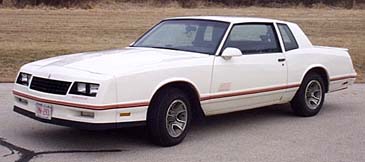 The
1988 model year marked the end of an era. The Aero Coupe had been
dropped. The Monte Carlo was made available in LS and SS versions only.
After approximately three months of production, Chevrolet opted to completely
cancel the Monte Carlo model. Sadly, production of the Monte Carlo ceased
on Friday, December 11, 1987, at 5:29 PM. The very last vehicle to roll
off the dual purpose The
1988 model year marked the end of an era. The Aero Coupe had been
dropped. The Monte Carlo was made available in LS and SS versions only.
After approximately three months of production, Chevrolet opted to completely
cancel the Monte Carlo model. Sadly, production of the Monte Carlo ceased
on Friday, December 11, 1987, at 5:29 PM. The very last vehicle to roll
off the dual purpose
Pontiac, MI assembly line
was actually a Buick Grand National. 1988 was the last anyone would see
of the Monte Carlo for seven long years.
Fifth Generation
(1995-1999)
Reintroduced in mid-1994
as a 1995 model, was the exciting new Monte Carlo Coupe. The basic vehicle
format had been changed significantly. The Monte Carlo no longer had a
full frame, but utilized unibody construction and was made front wheel
drive. It featured a standard 3.1 liter V-6 with 4-speed automatic
transmission. The body was shaped with a "bullet" nose and a rounded aerodynamic
form. The new Monte Carlo bore no resemblance to the Monte Carlo of old.
There were no "Knight" emblems and no V-8 engine. There was no SS package,
but this was intentional. The 1995 Monte was meant to appeal to the 1990's
buyer and offer luxury, safety and affordability. To interest the performance
minded, there was a Z34 option available. It included a 3.4 liter, overhead
cam V-6 engine with 210 net horsepower.
Gone from the Monte Carlo
were the V-8 and rear wheel drive; but not since 1975 had the Monte Carlo
had as much net horsepower. In addition, there were features never before
offered in the Monte Carte: Anti-lock brakes, dual airbags, sequential
port fuel injection and a Compact Disc audio system. Overall, the reborn
Monte Carlo was a well-rounded package of performance, safety, luxury and
style.
In 1996, new for the
Monte Carlo were three new exterior colors: granite (met), medium
green lichen (met) and dark carmine red (met). Also new for the LS model
was climate controls for both driver and passenger sides. The Monte Carlo
could still be chosen with the optional Z34 package. The Z34 package
offered 4-wheel anti-lock disc brakes, front and rear and one new exterior
color: dark carmine red (met). Speed compensating volume control for both
radios in the LS and Z34 were offered new for this model year. Constantly
improving on safety aspects of the Monte Carlo, produced automatic
daytime running lamps, new
for 1997. Chevrolet made some handling improvements to the LS model in
the form of 16 mm rear stabilizer bars and a change in rear spring rates.
For 1997, there was an option for a sunroof, for those owners that
would rather have the fresh air blowing through the vehicle, but not sacrificing
the hair- do. One of the neatest improvements for 1997 were the new oil
wear sensor indicator, this particular feature will inform an owner when
the time has come to have an oil change performed. The oil wear indicator
and daytime running lights, were standard features. For 1997 there were
only two Brickyard 400 pace cars. One of the cars will stay at Indianapolis
Motor
Speedway and the other will
be kept by Chevrolet.
MONTE CARLO 1999
New for 1999: Chevrolet revived
a famous and much-loved name when the current Monte Carlo was introduced
in 1995. The 1999 Monte Carlo remains unchanged from last year.
History: The original Monte
Carlo debuted in the 1970 model year as a personal luxury 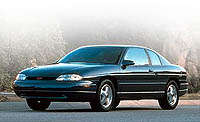 coupe,
although the high-performance SS454 trim joined the lineup midyear. Throughout
the '70s and '80s the car's focus shifted from luxury to value, to
a diesel engine (!), then to performance, with the third-generation
car finally being discontinued in 1988. The current Monte Carlo's
shape is a favorite in stock car racing, and Monte Carlo-bodied cars have
had considerable success on the NASCAR circuit. Monte Carlo is built
on the same front-wheel-drive platform as the Lumina, and is the
bestseller in its class. While the sporty Z34 is purchased mostly by
men, women make up the majority of Monte Carlo LS buyers. coupe,
although the high-performance SS454 trim joined the lineup midyear. Throughout
the '70s and '80s the car's focus shifted from luxury to value, to
a diesel engine (!), then to performance, with the third-generation
car finally being discontinued in 1988. The current Monte Carlo's
shape is a favorite in stock car racing, and Monte Carlo-bodied cars have
had considerable success on the NASCAR circuit. Monte Carlo is built
on the same front-wheel-drive platform as the Lumina, and is the
bestseller in its class. While the sporty Z34 is purchased mostly by
men, women make up the majority of Monte Carlo LS buyers.
Model years: 1988, 95-98
Trim Details: The 1999 Chevrolet
Monte Carlo is available in two trims: LS and Z34 2-door coupes.
Safety features include dual airbags, an anti-lock brake system (ABS) and
daytime running lights. The LS comes with a 160-horsepower 3.1-liter
V6, while the Z34 features a 3.8-liter 200-horsepower V6 engine.
Standard equipment includes air conditioning, tinted glass, a theft-deterrent
system, power windows and door locks, intermittent wipers, a tilt
steering wheel, and an AM/FM stereo cassette. The Z34 adds dual exhaust,
remote keyless entry, dual-zone climate control, cruise control,
16-inch aluminum wheels and performance tires. Optional items on
both trims include power leather seats, an electric sunroof and the
OnStar mobile communications system. |